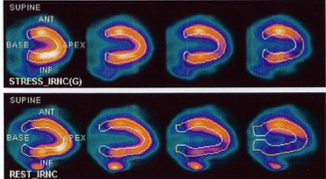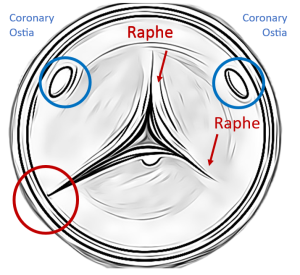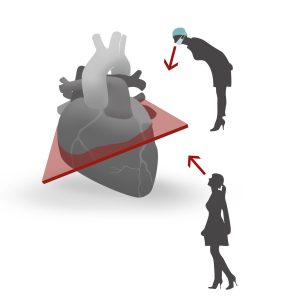This week we are continuing the discussion of the movement in nuclear cardiology towards patient centered imaging and the emphasis on reduction of radiation exposure. Many organizations are changing guidelines and standards to align with these principles, one of them being the Intersocietal Accreditation Commission (IAC). Patient centered imaging is the focus of many changes in nuclear accreditation guidelines. In our last blog, we discussed 5 ways to reduce radiation exposure. IAC implemented all of these in their guidelines. Here is a quick review:
5 WAYS TO REDUCE RADIATION EXPOSURE
- Perform the stress portion of the test first, review the images and determine whether the rest portion is necessary.
- Use radionuclides with shorter half-life such as Tc-99m.
- Use weight based dosing
- Use the newest software that can optimize images while lowering radiation dose.
- Use newer hardware methods that provide better quality images with reduced time and radiation dose.
LOWEST RADIATION DOSE NECESSARY
The main goal of this blog is to remind our readers: There is no protocol that is optimal for every patient. As medical providers, we should all strive to implement patient-centered imaging. If your facility is performing the same SPECT protocol for all patients there is room for improvement of patient care.
In February 2016, the American Society of Nuclear Cardiology (ASNC) released an updated Imaging Guidelines for Nuclear Cardiology Procedures. These guidelines included SPECT MPI imaging protocols with recommended effective doses. The table is broken down into the following sections:
- Tc-99m
- Tl-201
- I-123
- Newer Technology Reduced Dose Protocols.
When reviewing the effective dose reference table the following applies:
- Large patient is defined as >250 lbs or BMI >35
- (Rest)** denotes optional rest injection and only performed where clinically warranted
- There are circumstances in which the administered dose will exceed the ranges listed
- Justification must be kept on file
- Protocols may include individualized weight based dosing strategies
Tc-99m Protocols
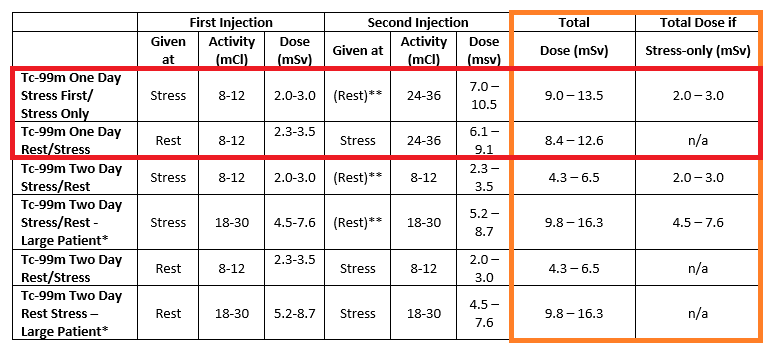
Tc-99m protocols are preferred as they have a shorter half-life while producing better quality images. The protocol and dosing amount should be tailored to the patient and the specific clinical situation. Using the example of a one day Stress/Rest protocol the table provides a Stress range of 8-12 and a Rest (if needed) range of 24-36. How do you determine the dose that’s best for your patient? Some labs use the following criteria for the resting dose with a stress dose of three times the rest:

Tl-201 Protocols
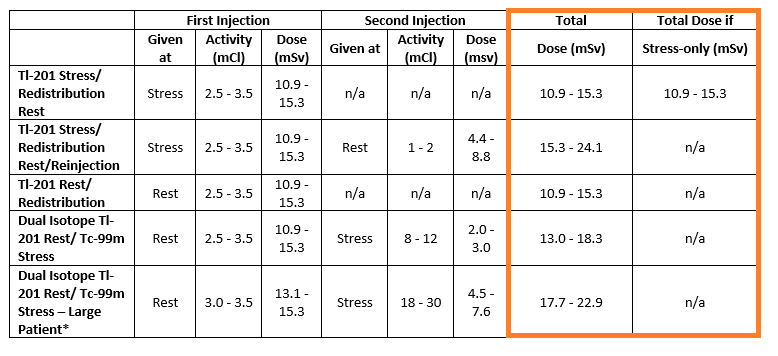
ASNC recommends against performing dual isotope myocardial perfusion imaging (MPI). There is significantly higher radiation dose to the patient and using different isotopes increases the false positive rate for ischemia
Newer Technology Reduced-Dose Protocols
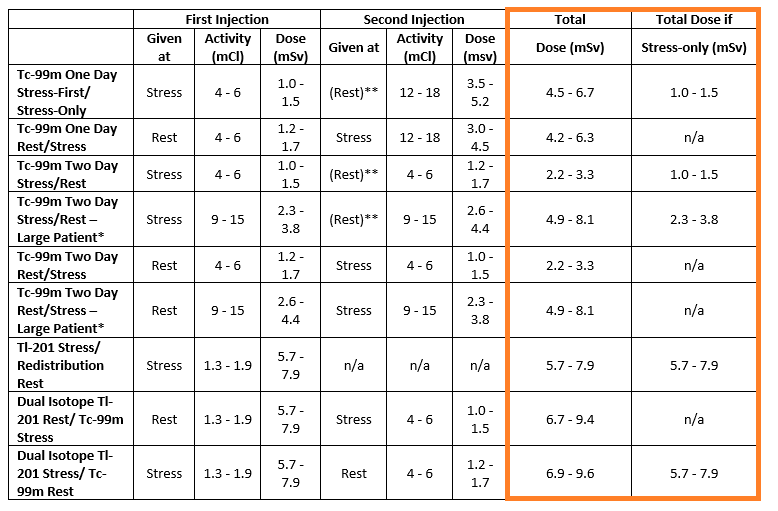
Newer iterative reconstruction software can optimize nuclear imaging reducing the time and/or dose administered. The software can be fitted on most existing systems if the gamma cameras are DICOM-compliant. Most major vendors offer technology with the systems. If your facility has not implemented this software, talk to your vendor about acquiring it.
- UltraSpect Xpress Cardiac is a software that can increase SPECT acquisition without compromising image quality. It is compatible with most major manufacturers’ cameras and workstations.
If your facility is considering buying a new machine, there is newer hardware that can reduce radiation dose significantly. These include:
- Cadmium zinc telluride (CZT) detectors are more efficient and reduce the amount of radiotracer needed. They are offered on GE Healthcare (Discovery 570c SPECT/CT, Discovery 530c systems) and Spectrum Dynamics Medical (D-Spect)
NEW IAC RADIATION SAFETY RECOMMENDATIONS
IAC updated their nuclear standards in September of 2016 that were in alignment with ASNC’s updates. The changes related to radiation safety include a focus on patient centered imaging and include:
- Requirements for the Radiation Protection Program:
- The annual review must include protocol evaluation to minimize the effective radiation dose while producing interpretable, diagnostic quality images
- Records of this review must include program changes, noted deficiencies and actions taken
- Records must include justification of any administered radiopharmaceutical dose exceeding standards protocol for adults
- Administration of radiopharmaceuticals to patients:
- Administered radiopharmaceuticals must use the lowest radiation dose necessary to acquire a diagnostic quality image
- Facilities must document the system for adjusting dosages for patient size/weight
- An onsite dose calibrator helps dose adjustment based on the patient’s weight
- Clinical Protocol guidelines:
- Protocols should use the lowest radiation dose necessary to acquire a diagnostic-quality image and must be within the ASNC effective doses ranges
- Facilities must keep on file justification of dosing exceeding ASNC ranges. Protocols may include individualized weight based dosing strategies
- Strongly recommended for obese patients undergoing two-day MPI protocols or patients with a low pretest probability to have stress imaging performed first and rest imaging performed only if stress imaging is abnormal.
- Strongly recommended against the routine use of a dual isotope protocol for MPI testing except during technetium shortage or for use with Newer Technology combined with the Reduced-Dose Protocols
ALARA GOAL
Our goal is to ensure our patients receive radiation exposure As Low As Reasonably Possible (ALARA). ASNC states that a radiation effective dose of < 9 mSv in at least 50% of our studies is an extremely important goal for each laboratory to attain. What does that mean in everyday practice? If we look back at the table(s) above the total effective doses are highlighted in the orange boxes. If you pay attention to the one-day protocols often used in facilities (highlighted in the red box) you will notice the total effective dose for patients that receive both the stress and rest portion of their test is in the range of 8.4 – 13.5. Whereas patients that receive only the stress portion of their test receive a much lower dose of 2.0 – 3.0. In order for our labs to meet this extremely important ALARA goal we need to review our MPI protocols and ensure as many patients as possible only receive stress-only protocols.
Next week as we close out Radiation Safety Month at CardioServ we will review the new IAC Quality Improvement Guidelines and discuss how to incorporate Dose Verification assessment to meet your Technical Measure requirements.
RESOURCES
- IAC Nuclear/PET Standards
- ASNC Imaging Guidelines for SPECT nuclear cardiology procedures: Stress, protocols, and tracers
- ASNC Preferred Practice Statement: Patient-centered Imaging
- ASNC Information Statement: Recommendations for reducing radiation exposure in myocardial perfusion imaging
- AHA Scientific Statement: Approaches to Enhancing Radiation Safety in Cardiovascular Imaging

